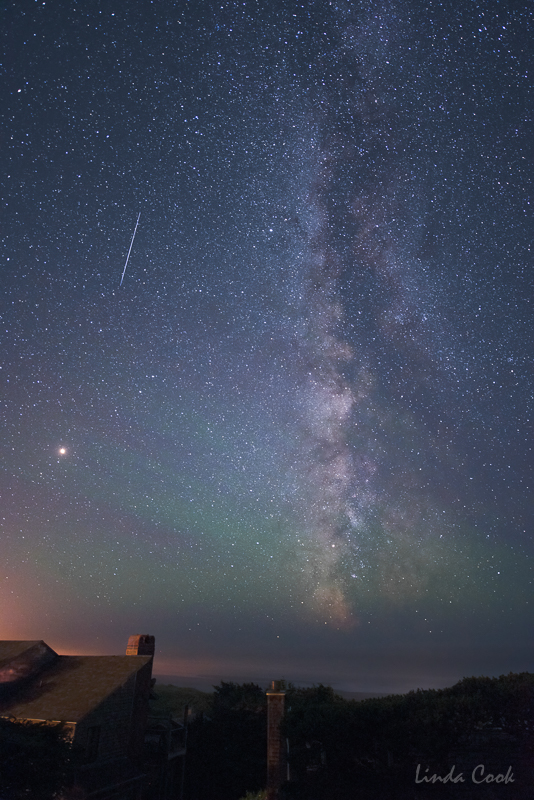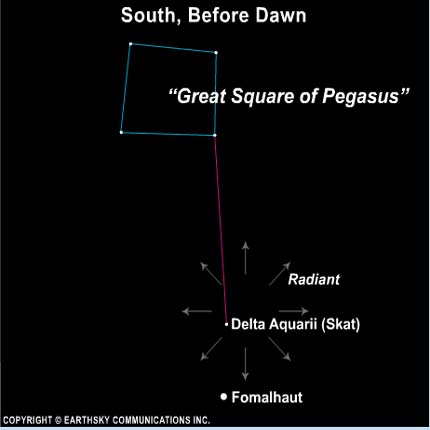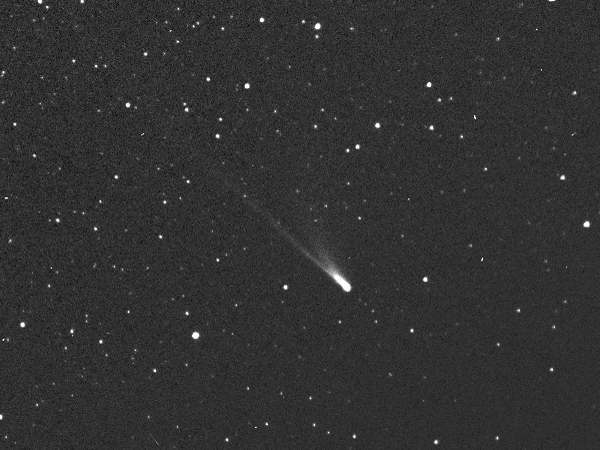Geno Ketchum caught the Milky Way over the Richland Creek Wilderness Area in Arkansas, with a huge shooting star, on July 13, 2018. He wrote: “I was very lucky to get this, probably a once in a lifetime shot for me.”
The Delta Aquariid meteor shower rambles along steadily from about July 12 to August 23 each year. In 2018, a full moon will drown out these meteors at the nominal peak night of the shower on July 27-28, 2018. But don’t let that worry you! Meteor numbers for this shower don’t bump up significantly at the peak; in fact, they’ll continue on into August and overlap with the famous Perseid meteor shower. The moon will turn new on August 11, 2018, providing dark skies for both the Perseids and the Delta Aquariids around then. So start watching for Delta Aquariid meteors now, until – around late July – the moon drowns you out. Then start watching again as you’re watching for the Perseids, as that more famous shower ramps up in early August.
The Perseids radiate from the constellation Perseus. The Delta Aquariids radiate from the constellation Aquarius. That means those August meteors will be flying from two different directions in the sky. Lots of fun to watch!

Linda Cook in Manzanita, Oregon, caught a meteor appearing to point toward the very bright planet Mars on July 12, 2018.
When and how to watch the Delta Aquariid meteor shower. Does this shower have a peak? It does have a nominal peak in late July, and, in 2018, the full moon will definitely intrude in late July. But no matter. This shower is long and rambling. As with many meteor showers, the best meteor-viewing hours are after midnight and before dawn. For the Delta Aquariids, the best time is centered around 2 a.m. (3 a.m. Daylight Saving Time) for all time zones around the world. So you’ll want to wait until the moon is out of the sky from at least, say, midnight or after. That means waiting until at least the first weekend of August (August 4-5, 2018) or even the following week (week of August 6, 2018) to begin looking for Delta Aquariid meteors in a moon-free sky, around midnight or after. The moon will be rising increasingly later each morning after that, interfering less and less with the meteors until new moon (no moon up at night) on August 11, and 2018’s moon-free and very convenient Perseids’ peak on the weekend of August 11-12.
The Delta Aquariid meteors tend to appear a bit fainter than the Perseids and meteors seen in other major showers. That makes a dark sky free of moonlight or city lights even more imperative for watching the annual Delta Aquariid shower.
The Delta Aquariid shower is said to favor the Southern Hemisphere. But viewers at mid-northern latitudes can see some of these meteors as well. In years when the moon is out of the way, the broad maximum of this shower can be expected to produce 10 to 20 meteors per hour, under a dark country sky.
About five to ten percent of the Delta Aquariid meteors leave persistent meteor trains – glowing ionized gas trails that last a second or two after the meteor has passed. The meteors burn up in the upper atmosphere about 60 miles (100 km) above the Earth’s surface. Watch for their lingering trains!
Everything you need to know: Perseid meteor shower

Radiant point for Delta Aquariid shower is near star Skat, or Delta Aquarii. This star is near in the sky to a much brighter star, Fomalhaut, which can be found roughly on a line drawn southward through the stars on the west side of the Great Square.
How to tell Perseid meteors from Delta Aquariid meteors. This is where the concept of a radiant point comes in handy. You never have to locate a shower’s radiant point to enjoy the meteors. But … if you trace all the Delta Aquariid meteors backward, they appear to radiate from a certain point in front of the constellation Aquarius the Water Bearer. As viewed from the Northern Hemisphere, this point – the Delta Aquariids’ radiant point – arcs across the southern sky. It’s overhead for Southern Hemisphere viewers (which is why the shower is best from that part of the world).
The radiant point of the Delta Aquariid shower nearly aligns with the star Skat (Delta Aquarii). The meteor shower is named in honor of this star.
Meanwhile, the Perseids radiate from the constellation Perseus, in the northeast to high in the north between midnight and dawn, as seen from the Northern Hemisphere. So if you’re in this hemisphere, and you’re out watching for meteors, and you see meteors coming from the northeast or north … they are Perseids. If you see them coming from the south … they are Delta Aquariids.
If you’re in the Southern Hemisphere, your Delta Aquariids will be radiating from nearly overhead. Your Perseids will be shooting up from somewhere along your northern horizon.
In a particularly rich year for meteors, if you have a dark sky, you might even see Perseid meteors cross paths with Delta Aquariid meteors! It can be an awesome display.

Comet 96P Machholz, the possible parent of the Delta Aquariid meteor shower, was discovered on May 12, 1986, by Donald Machholz. Photo via Wikimedia Commons.
Delta Aquariid meteors may come from Comet 96P Machholz. Meteor showers happen when our planet Earth crosses the orbital path of a comet. When a comet nears the sun and warms up, it sheds bits and pieces that spread out into that comet’s orbital stream. This comet debris slams into the Earth’s upper atmosphere at about 90,000 miles (150,000 km) per hour, vaporizing – burning up – as meteors or shooting stars.
The parent body of the Delta Aquariid meteor is not known with certainty. It was once thought to have originated from the breakup of what are now the Marsden and Kracht sungrazing comets. More recently, Comet 96P Machholz has loomed as the primary candidate for being the Delta Aquariids’ parent body.
Donald Machholz discovered this comet in 1986. It’s a short-period comet whose orbit carries it around the sun once in a little over five years. At aphelion – its greatest distance from the sun – this comet goes out beyond the orbit of Jupiter. At perihelion – its closest point to the sun – Comet 96P Machholz swings well inside Mercury’s orbit.
Comet 96P/Machholz last came to perihelion on October 27, 2017.
Bottom line: The Delta Aquariid meteor shower rambles along pretty steadily in late July and August, coinciding with the Perseids. From any time zone, the best viewing window is centered on roughly 2-3 a.m. Find an open sky away from artificial lights, lie down on a reclining lawn chair and look upward.
Everything you need to know: Perseid meteor shower
from EarthSky https://ift.tt/1z3xrSR
Geno Ketchum caught the Milky Way over the Richland Creek Wilderness Area in Arkansas, with a huge shooting star, on July 13, 2018. He wrote: “I was very lucky to get this, probably a once in a lifetime shot for me.”
The Delta Aquariid meteor shower rambles along steadily from about July 12 to August 23 each year. In 2018, a full moon will drown out these meteors at the nominal peak night of the shower on July 27-28, 2018. But don’t let that worry you! Meteor numbers for this shower don’t bump up significantly at the peak; in fact, they’ll continue on into August and overlap with the famous Perseid meteor shower. The moon will turn new on August 11, 2018, providing dark skies for both the Perseids and the Delta Aquariids around then. So start watching for Delta Aquariid meteors now, until – around late July – the moon drowns you out. Then start watching again as you’re watching for the Perseids, as that more famous shower ramps up in early August.
The Perseids radiate from the constellation Perseus. The Delta Aquariids radiate from the constellation Aquarius. That means those August meteors will be flying from two different directions in the sky. Lots of fun to watch!

Linda Cook in Manzanita, Oregon, caught a meteor appearing to point toward the very bright planet Mars on July 12, 2018.
When and how to watch the Delta Aquariid meteor shower. Does this shower have a peak? It does have a nominal peak in late July, and, in 2018, the full moon will definitely intrude in late July. But no matter. This shower is long and rambling. As with many meteor showers, the best meteor-viewing hours are after midnight and before dawn. For the Delta Aquariids, the best time is centered around 2 a.m. (3 a.m. Daylight Saving Time) for all time zones around the world. So you’ll want to wait until the moon is out of the sky from at least, say, midnight or after. That means waiting until at least the first weekend of August (August 4-5, 2018) or even the following week (week of August 6, 2018) to begin looking for Delta Aquariid meteors in a moon-free sky, around midnight or after. The moon will be rising increasingly later each morning after that, interfering less and less with the meteors until new moon (no moon up at night) on August 11, and 2018’s moon-free and very convenient Perseids’ peak on the weekend of August 11-12.
The Delta Aquariid meteors tend to appear a bit fainter than the Perseids and meteors seen in other major showers. That makes a dark sky free of moonlight or city lights even more imperative for watching the annual Delta Aquariid shower.
The Delta Aquariid shower is said to favor the Southern Hemisphere. But viewers at mid-northern latitudes can see some of these meteors as well. In years when the moon is out of the way, the broad maximum of this shower can be expected to produce 10 to 20 meteors per hour, under a dark country sky.
About five to ten percent of the Delta Aquariid meteors leave persistent meteor trains – glowing ionized gas trails that last a second or two after the meteor has passed. The meteors burn up in the upper atmosphere about 60 miles (100 km) above the Earth’s surface. Watch for their lingering trains!
Everything you need to know: Perseid meteor shower

Radiant point for Delta Aquariid shower is near star Skat, or Delta Aquarii. This star is near in the sky to a much brighter star, Fomalhaut, which can be found roughly on a line drawn southward through the stars on the west side of the Great Square.
How to tell Perseid meteors from Delta Aquariid meteors. This is where the concept of a radiant point comes in handy. You never have to locate a shower’s radiant point to enjoy the meteors. But … if you trace all the Delta Aquariid meteors backward, they appear to radiate from a certain point in front of the constellation Aquarius the Water Bearer. As viewed from the Northern Hemisphere, this point – the Delta Aquariids’ radiant point – arcs across the southern sky. It’s overhead for Southern Hemisphere viewers (which is why the shower is best from that part of the world).
The radiant point of the Delta Aquariid shower nearly aligns with the star Skat (Delta Aquarii). The meteor shower is named in honor of this star.
Meanwhile, the Perseids radiate from the constellation Perseus, in the northeast to high in the north between midnight and dawn, as seen from the Northern Hemisphere. So if you’re in this hemisphere, and you’re out watching for meteors, and you see meteors coming from the northeast or north … they are Perseids. If you see them coming from the south … they are Delta Aquariids.
If you’re in the Southern Hemisphere, your Delta Aquariids will be radiating from nearly overhead. Your Perseids will be shooting up from somewhere along your northern horizon.
In a particularly rich year for meteors, if you have a dark sky, you might even see Perseid meteors cross paths with Delta Aquariid meteors! It can be an awesome display.

Comet 96P Machholz, the possible parent of the Delta Aquariid meteor shower, was discovered on May 12, 1986, by Donald Machholz. Photo via Wikimedia Commons.
Delta Aquariid meteors may come from Comet 96P Machholz. Meteor showers happen when our planet Earth crosses the orbital path of a comet. When a comet nears the sun and warms up, it sheds bits and pieces that spread out into that comet’s orbital stream. This comet debris slams into the Earth’s upper atmosphere at about 90,000 miles (150,000 km) per hour, vaporizing – burning up – as meteors or shooting stars.
The parent body of the Delta Aquariid meteor is not known with certainty. It was once thought to have originated from the breakup of what are now the Marsden and Kracht sungrazing comets. More recently, Comet 96P Machholz has loomed as the primary candidate for being the Delta Aquariids’ parent body.
Donald Machholz discovered this comet in 1986. It’s a short-period comet whose orbit carries it around the sun once in a little over five years. At aphelion – its greatest distance from the sun – this comet goes out beyond the orbit of Jupiter. At perihelion – its closest point to the sun – Comet 96P Machholz swings well inside Mercury’s orbit.
Comet 96P/Machholz last came to perihelion on October 27, 2017.
Bottom line: The Delta Aquariid meteor shower rambles along pretty steadily in late July and August, coinciding with the Perseids. From any time zone, the best viewing window is centered on roughly 2-3 a.m. Find an open sky away from artificial lights, lie down on a reclining lawn chair and look upward.
Everything you need to know: Perseid meteor shower
from EarthSky https://ift.tt/1z3xrSR

Aucun commentaire:
Enregistrer un commentaire